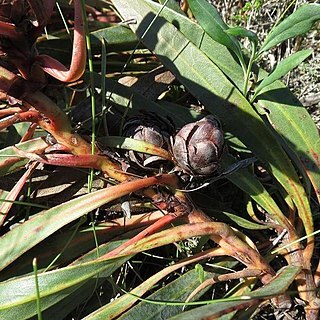Dwarf shrub, lignotuberous sparsely branched, spreading, 0.5-0.9 m high. Leaves pointing vertically from horizontal stems, petiolate, linear to lanceolate, 80-180 x 2-28 mm, midrib prominent, hairless when mature, acute to obtuse. Flower head bowlshaped, 40-60 mm in diam., overtopped by surrounding leaves. Involucral bracts 4-or 5-seriate; outer series broadly ovate, obtuse to rounded, 10-20 x 10-20 mm, green-yellow flushed carmine, fine hairs on outer surface, outermost bracts with leaf-like extensions; inner series oblong, rounded, 35-40 x 10-15 mm. Flowers 25-30 mm long, straight, tube 8 mm long, glabrous, tips with white-woolly hairs; style 25-30 mm long, straight to slightly curved; pollen presenter 5 mm long, linear. Flowering time May-Sept.
Trailing, resprouting shrub to 4 m diam. Leaves secund, linear-oblanceolate. Flower heads cup-shaped, 40-60 mm diam., involucral bracts green to yellow, flushed pink, margins silky, style 25-30 mm long.


